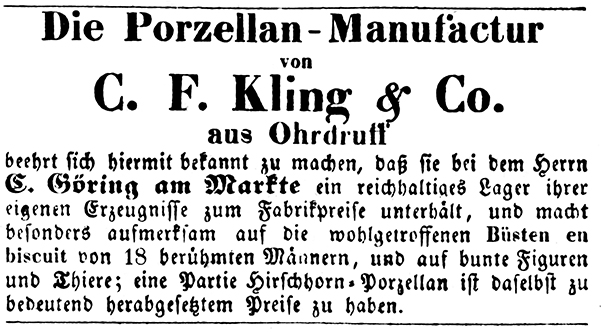Antique porcelain Kling dolls originate in Ohrdruf (Ohrdruff), Germany at the porcelain factory started by Christian Friedrich Kling in 1834 and his firm called “C. F. Kling & Co.”
Kling Porcelain Pipe Bowls in 1837
C. F. Kling at one time manufactured porcelain pipe bowls. He announced an Easter sale in 1837 of the pipes in the Frankfurt newspaper as an effort to clear out his stock at that time.
Bisque Busts of Famous Men (1840)
The Allgemeiner Anzeiger und Nationalzeitung der Deutschen (General Advertiser and National Newspaper of the German) announced to its readers in 1840, “Purchase and trading items. The porcelain factory of C. F. Kling and Co. in Ohrdruff near Gotha has the honor of drawing the attention of the trading and art-loving public to the 23 biscuit busts of the following famous men: King Frederick II, King Frederick William III, King Frederick William IV, Prince William Carl of Prussia, Napoleon, Schiller, Goethe, Wieland, Körner, Rousseau, Voltaire, Franklin, Hahnemann, Mozart, Haydn, Mendelsohn, Jean Paul, Klopstock, Shakespeare, Guttenberg, Emperor Nicholas I, King of Württemberg, Walter Scott, Washington, Beethoven, Byron, Mehemed Ali. All busts are made from the best available originals and the prices are very reasonable.”

The same year C. F. Kling & Co. offered bisque busts and statues by Gutenberg, made after the best original, in various sizes “at very reasonable prices” at a local celebration for a book printer’s anniversary. They listed themselves as the Porzellan-Fabrik in Ohrdruf near Gotha. They made the announcement in the Frankfurter Ober-Post-Amts-Zeitung (a Frankfurt newspaper).
Kling Dolls at Leipzig Trade Fair
The Leipzig Trade Fair Address Book of 1897 gave this listing (translated) for C. F. Kling, “Ohrdruf (Thuringia), porcelain factory, doll heads, bathing children, Nanking dolls etc. – O.-V. Auerbachs. Hof, Tr. C. II.”
The Leipzig Trade Fair Address Book of 1900 gave this listing (translated), “Kling & Co., C. F., Ohrdruf (Thuringia) porcelain factory, bisque babies, bathing children, etc. – only for O. -V. – Auerbachs. Hof, Tr. C. II. Left 3 rooms.”
1883 Kling Dolls in the Leuch’s Addressbook
The half page ad for C. F. Kling in Leuch’s address book in 1883 reads (translated), “C. F. Kling & Co. Porcelain factory. Ohrdruf in Thuringia. SPECIALTIES: Figures, vases, children’s figures, dolls, bathing children, doll heads etc. Founded in 1836. For the trade fair in Leipzig: Auerbachshof C. II.”
In 1900 The Officia Leipzig Trade Fair Addressbook gave the following listing, “Kling & Co., C. F., Ohrdruf (Thüringen), Porzellanfabrik, Spec.: Puppenköpfe, Bisquit-Babies, Badekinder etc. — Nur zur O.- V. Auerbachs Hof, Tr. C, II, links, 3. Zimmer.”
The Address Book of the Saxon-Thuringian Industry in 1907 mentions C. F. Kling & Co., Ohrdruf, Porcelain dolls. Then in 1911 the book expresses porcelain (figurines and toys).
Kling Dolls’s Trademark

In 1901 Sprechsaal published the factory mark for C. F. Kling & Co showing the bell with the letter K on it. The mark listing read “C. F. Kling & Co., Porzellanfabrik, Ohrdruf in Thuringen. Puppenkopfe, Biscuit-Puppen, Nankingruppen, Nippes. Badekinder etc.” (bisque doll heads, dolls, nankeen dolls, knick knacks, bathing children, etc.)
Kling Figures on Display in 1885
The Bavarian Trade Museum (Bayerisches Gewerbemuseum) had two Kling porcelain busts on display in 1885 according to a german newspaper.
Identifying Kling Dolls
Mary Gorham Krombholz published three books that help collectors identify and distinguish between some different German china and parian head dolls.
Identifying German Chinas 1840s-1930s
The simplest Identifying German Chinas 1840s-1930s divides the chapters into eras by decade. For example in the chapter for the 1860s one can see various china head dolls with similar hairstyles popular during that decade. Krombholz presents 1860s doll heads by Conta & Boehme; A. W. Fr. Kister; Kestner & Co.; Alt, Beck & Gottschalck; and others. This type of presentation helps someone distinguish between the molding of the hairstyles and facial features, as well as the facial painting of these very similar dolls.
Identifying German Parian Dolls
In her book Identifying German Parian Dolls Krombholz presents wonderful images and descriptions of parian porcelain head dolls (non-glazed). Each chapter she dedicates to a specific well known German manufacturer. Chapter three holds a collection of dolls manufactured by C. F. Kling & Co. She includes photos of the front of the dolls’ faces as well as the back of the head.
A Pictorial Reference Guide for German Chinas
In her rarest and most practical book, A Pictorial Reference Guide for German Chinas, Krombholz presents chapters dedicated to the different manufacturers. Chapter five describes the C. F. Kling & Co. porcelain factory and the dolls with extra images not found in either of the previously mentioned books. The chapter also has insightful details about the factory along with photos of her visit to the factory. It is this blogger’s favorite of books for identifying German chinas and admiring the works of C. F. Kling.
